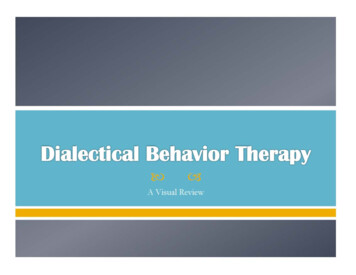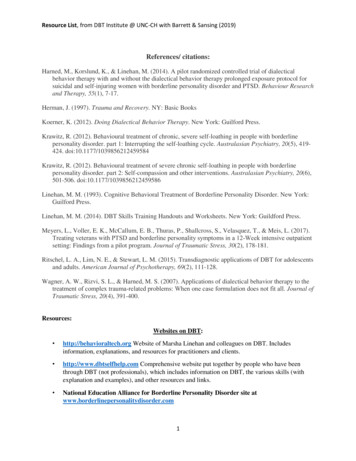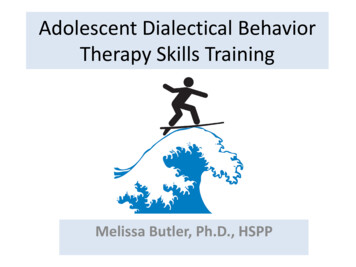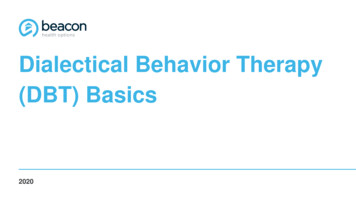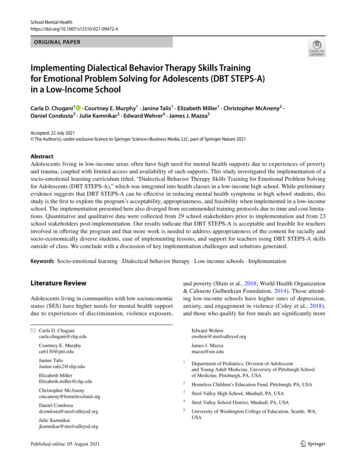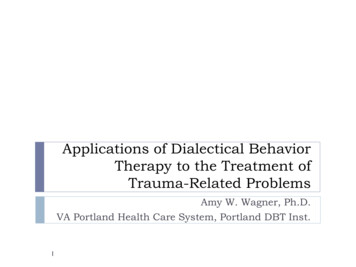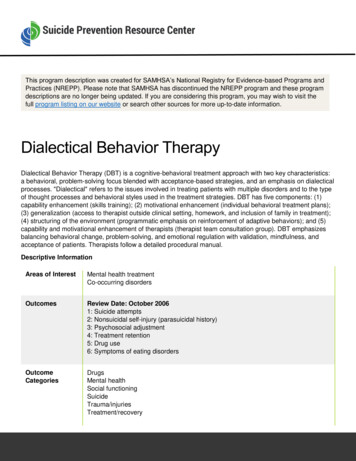
Transcription
This program description was created for SAMHSA’s National Registry for Evidence-based Programs andPractices (NREPP). Please note that SAMHSA has discontinued the NREPP program and these programdescriptions are no longer being updated. If you are considering this program, you may wish to visit thefull program listing on our website or search other sources for more up-to-date information.Dialectical Behavior TherapyDialectical Behavior Therapy (DBT) is a cognitive-behavioral treatment approach with two key characteristics:a behavioral, problem-solving focus blended with acceptance-based strategies, and an emphasis on dialecticalprocesses. "Dialectical" refers to the issues involved in treating patients with multiple disorders and to the typeof thought processes and behavioral styles used in the treatment strategies. DBT has five components: (1)capability enhancement (skills training); (2) motivational enhancement (individual behavioral treatment plans);(3) generalization (access to therapist outside clinical setting, homework, and inclusion of family in treatment);(4) structuring of the environment (programmatic emphasis on reinforcement of adaptive behaviors); and (5)capability and motivational enhancement of therapists (therapist team consultation group). DBT emphasizesbalancing behavioral change, problem-solving, and emotional regulation with validation, mindfulness, andacceptance of patients. Therapists follow a detailed procedural manual.Descriptive InformationAreas of InterestMental health treatmentCo-occurring disordersOutcomesReview Date: October 20061: Suicide attempts2: Nonsuicidal self-injury (parasuicidal history)3: Psychosocial adjustment4: Treatment retention5: Drug use6: Symptoms of eating disordersOutcomeCategoriesDrugsMental healthSocial y
Dialectical Behavior TherapyAgesGenders18-25 (Young adult)26-55 (Adult)55 (Older adult)MaleFemaleRaces/EthnicitiesAmerican Indian or Alaska NativeAsianBlack or African AmericanHispanic or LatinoWhiteRace/ethnicity unspecifiedSettingsInpatientOutpatientOther community settingsGeographicLocationsImplementationHistoryNo geographic locations were identified by the developer.DBT has been implemented in many therapeutic settings in Argentina, Australia,Canada, Germany, Japan, New Zealand, the Netherlands, Norway, Spain, Sweden,Switzerland, the United Kingdom, and the United States since the publication oftreatment manuals in 1993. Evaluations of DBT have been conducted in Canada,Germany, the Netherlands, New Zealand, Spain, and Sweden. Some clinicians haveconducted and published results from independent randomized controlled trials ofDBT.NIHFunding/CERStudiesPartially/fully funded by National Institutes of Health: YesEvaluated in comparative effectiveness research studies: YesAdaptationsAdaptations of DBT have been developed for: Suicidal adolescents Individuals with substance use disorders Individuals with eating disorders Individuals with comorbid HIV and substance use disorders2
Dialectical Behavior TherapyAdverse EffectsIOM PreventionCategories Developmentally delayed individuals Older adults with depression and one or more personality disorders Individuals with schizophrenia Families of patients Women experiencing domestic violence Violent intimate partners Individuals who stalk Inpatient and partial hospitalization settings for adolescents and adults Forensic settings for juveniles and adultsNo adverse effects, concerns, or unintended consequences were identified by thedeveloper.IOM prevention categories are not applicable.Learn More - Click on each category bar below or the buttons at the right to expand or collapse the sections.Quality of ResearchReview Date: October 2006Documents ReviewedThe documents below were reviewed for Quality of Research. The research point of contact can provideinformation regarding the studies reviewed and the availability of additional materials, including those frommore recent studies that may have been conducted.Study 1Bohus, M., Haaf, B., Simms, T., Limberger, M. F., Schmahl, C., Unckel, C., et al. (2004). Effectiveness ofinpatient dialectical behavior therapy for borderline personality disorder: A controlled trial. BehaviourResearch and Therapy, 42, 487-499.Study 2Linehan, M. M., Armstrong, H. E., Suarez, A., Allmon, D., & Heard, H. L. (1991). Cognitive-behavioraltreatment of chronically parasuicidal borderline patients. Archives of General Psychiatry, 48, 1060-1064.3
Dialectical Behavior TherapyStudy 3Linehan, M. M., Comtois, K. A., Murray, A. M., Brown, M. Z., Gallop, R. J., Heard, H. L., et al. (n.d.).Dialectical behavior therapy versus treatment-by-experts for suicidal individuals with borderline personalitydisorder: One year treatment and one year follow-up. Unpublished manuscript.Study 4Linehan, M. M., Dimeff, L. A., Reynolds, S. K., Comtois, K. A., Welch, S. S., Heagerty, P., et al. (2002).Dialectical behavior therapy versus comprehensive validation therapy plus 12-Step for the treatment ofopioid dependent women meeting criteria for borderline personality disorder. Drug and AlcoholDependence, 67, 13-26.Study 5Linehan, M. M., Heard, H. L., & Armstrong, H. E. (1993). Naturalistic follow-up of a behavioral treatment forchronically parasuicidal borderline patients. Archives of General Psychiatry, 50, 971-974.Study 6Linehan, M. M., Schmidt, H., III, Dimeff, L. A., Craft, J. C., Kanter, J., & Comtois, K. A. (1999). Dialecticalbehavior therapy for patients with borderline personality disorder and drug-dependence. American Journalon Addictions, 8, 279-292.Study 7Linehan, M. M., Tutek, D. A., Heard, H. L., & Armstrong, H. E. (1994). Interpersonal outcome of cognitivebehavioral treatment for chronically suicidal borderline patients. American Journal of Psychiatry, 151, 17711776.Study 8Safer, D. L., Telch, C. F., & Agras, W. S. (2001). Dialectical behavior therapy for bulimia nervosa. AmericanJournal of Psychiatry, 158, 632-634.Study 9Telch, C. F., Agras, W. S., & Linehan, M. M. (2001). Dialectical behavior therapy for binge eating disorder.Journal of Consulting and Clinical Psychology, 69, 1061-1065.Study 10Turner, R. M. (2000). Naturalistic evaluation of dialectical behavior therapy-oriented treatment for borderlinepersonality disorder. Cognitive and Behavioral Practice, 7, 413-419.Study 11van den Bosch, L. M., Verheul, R., Schippers, G. M., & van den Brink, W. (2002). Dialectical behaviortherapy of borderline patients with and without substance use problems: Implementation and long-termeffects. Addictive Behaviors, 27, 911-923.Study 124
Dialectical Behavior TherapyVerheul, R., van den Bosch, L. M., Koeter, M. W., De Ridder, M. A., Stijnen, T., & van den Brink, W. (2003).Dialectical behaviour therapy for women with borderline personality disorder: 12-month, randomised clinicaltrial in the Netherlands. British Journal of Psychiatry, 182, 135-140.Supplementary MaterialsDialectical behavior therapy: Efficacy, effectiveness & feasibility [Handout]Dimeff, L., Koerner, K., & Linehan, M. M. (2002). Summary of research on dialectical behavior therapy.Seattle, WA: Behavioral Tech, LLC.Letters to the editor. (1993). Archives of General Psychiatry, 50, 157-158.Linehan, M. M. (1993). Cognitive-behavioral treatment of borderline personality disorder. New York:Guilford.Linehan, M. M. (1993). Skills training manual for treating borderline personality disorder. New York:Guilford.Robins, C. J., & Chapman, A. L. (2004). Dialectical behavior therapy: Current status, recent developments,and future directions. Journal of Personality Disorders, 18, 73-89.OutcomesOutcome 1: Suicide attemptsDescriptionof MeasuresSuicide attempts were measured by the Parasuicide History Interview (now called theSuicide Attempt Self-Injury Interview, or SASII), a semistructured interview administeredby blind assessors.KeyFindingsAfter 1 year of care during a randomized controlled trial, 23.1% of DBT participantsreported suicide attempts, compared with 46.7% of recipients of alternative experttreatment (p .005).StudiesMeasuringOutcomeStudy 3StudyDesignsExperimentalQuality ofResearchRating3.7 (0.0-4.0 scale)5
Dialectical Behavior TherapyOutcome 2: Nonsuicidal self-injury (parasuicidal history)Descriptionof MeasuresNonsuicidial self-injury (parasuicidal history) or NSSI refers to deliberate self-harm, suchas self-mutilation or drug overdose, in which suicide is not intended. This outcome wasmeasured by blind assessors using the Parasuicide History Interview (now called theSuicide Attempt Self-Injury Interview, or SASII).KeyFindingsMultiple evaluations, including randomized controlled trials and independent studies,confirmed that patients completing 1 year of DBT experienced less nonsuicidal selfinjury than patients awaiting care or receiving alternative treatment (p .05). In oneevaluation, DBT patients averaged 0.55 incidents during the previous month comparedwith 9.33 incidents in a treatment-as-usual group (p .05). In two other evaluations,DBT participants experienced incidents of nonsuicidal self-injury with a frequencycomparable to that of recipients of alternative professional treatment.StudiesMeasuringOutcomeStudy 1, Study 2, Study 3, Study 5, Study 6, Study 10, Study 11, Study 12StudyDesignsExperimentalQuality ofResearchRating3.3 (0.0-4.0 scale)Outcome 3: Psychosocial adjustmentDescriptionof MeasuresPsychosocial adjustment was measured by standardized self-reports and blind assessorreports. Measures included the Social Adjustment Scale and Longitudinal InterviewFollow-Up Evaluation, Global Assessment Scale, Hamilton Rating Scale for Depression,State-Trait Anger Expression Inventory, and self-reports on targeted behaviors, amongothers.KeyFindingsSeven randomized controlled trials found that 1 year of DBT improved at least somemeasures of psychological, social, or global adjustment, when compared with results forpatients awaiting care or receiving alternative treatment (p .05 across multiplemeasures). Two evaluations found sustained effects 16 and 18 months after treatment,6
Dialectical Behavior Therapyrespectively. One evaluation noted reduced anger among DBT participants 24 monthsafter treatment.StudiesMeasuringOutcomeStudy 1, Study 3, Study 4, Study 5, Study 6, Study 7, Study 10StudyDesignsExperimentalQuality ofResearchRating3.4 (0.0-4.0 scale)Outcome 4: Treatment retentionDescriptionof MeasuresKeyFindingsTreatment retention was measured by clinicians' records of attendance.In multiple evaluations, DBT participants remained in treatment longer than patientsreceiving treatment as usual or alternative treatment (p .002). DBT retention ratesranged from 63% to 100%, depending on the evaluation format, while retention rates forcomparative treatment in the same studies ranged from 23% to 73%.StudiesMeasuringOutcomeStudy 2, Study 3, Study 6, Study 12StudyDesignsExperimentalQuality ofResearchRating3.4 (0.0-4.0 scale)Outcome 5: Drug use7
Dialectical Behavior TherapyDescriptionof MeasuresDrug use was measured by urine samples and structured clinical interviews. Interviewsincluded the Timeline Followback Interview, administered by blind assessors.KeyFindingsIn a randomized controlled trial, DBT participants were significantly more likely thanalternative-treatment recipients to have drug-free urine screens 4 months aftercompleting a year-long course of treatment; effect size was medium (Cohen's d 0.75).In another evaluation, most DBT participants continued to reduce their use of opiatedrugs over the course of 1 year of treatment, while alternative-treatment recipientstypically increased their use during the last 4 months of treatment (p .05).StudiesMeasuringOutcomeStudy 4, Study 6, Study 11StudyDesignsExperimentalQuality ofResearchRating3.3 (0.0-4.0 scale)Outcome 6: Symptoms of eating disordersDescriptionof MeasuresSymptoms of eating disorders were measured by the Eating Disorders Examination,which diagnoses disorders and measures number of days and episodes of binge eating,and the Binge Eating Scale, which measures severity of eating disorder.KeyFindingsDBT participants reported significantly less binging or purging behavior than patientsawaiting treatment (p .05). In one evaluation, 89% of DBT participants were free ofpurge behavior, compared with 12.5% of patients awaiting care (p .001).StudiesMeasuringOutcomeStudy 8, Study 9StudyDesignsExperimental8
Dialectical Behavior TherapyQuality ofResearchRating3.2 (0.0-4.0 scale)Study PopulationsThe following populations were identified in the studies reviewed for Quality of Research.StudyAgeGenderRace/EthnicityStudy118-25 (Young adult)26-55 (Adult)100% FemaleData not reported/availableStudy218-25 (Young adult)26-55 (Adult)100% FemaleData not reported/availableStudy318-25 (Young adult)26-55 (Adult)100% Female87% White6% Race/ethnicity unspecified4% Black or African American2% Asian1% American Indian or Alaska NativeStudy418-25 (Young adult)26-55 (Adult)100% Female66% White26% Black or African American4% Race/ethnicity unspecifiedStudy518-25 (Young adult)26-55 (Adult)100% FemaleData not reported/availableStudy618-25 (Young adult)26-55 (Adult)100% Female78% White11% Race/ethnicity unspecified7% Black or African American4% Hispanic or LatinoStudy718-25 (Young adult)26-55 (Adult)100% FemaleData not reported/availableStudy818-25 (Young adult)26-55 (Adult)100% Female87.1% White12.9% Race/ethnicity unspecified9
Dialectical Behavior TherapyStudy918-25 (Young adult)26-55 (Adult)55 (Older adult)100% Female94% White6% Race/ethnicity unspecifiedStudy1018-25 (Young adult)26-55 (Adult)79.2% Female20.8% Male79.2% White16.7% Black or African American4.2% AsianStudy1126-55 (Adult)100% FemaleData not reported/availableStudy1226-55 (Adult)100% FemaleData not reported/availableQuality of Research Ratings by Criteria (0.0-4.0 scale)External reviewers independently evaluate the Quality of Research for an intervention's reported resultsusing six criteria:1. Reliability of measures2. Validity of measures3. Intervention fidelity4. Missing data and attrition5. Potential confounding variables6. Appropriateness of analysisFor more information about these criteria and the meaning of the ratings, see Quality of blesDataAnalysisOverallRating1: Suicide attempts3.83.84.03.53.04.03.72: Nonsuicidal selfinjury (parasuicidalhistory)3.83.83.32.92.63.73.33: Psychosocialadjustment4.04.03.03.22.73.73.410
Dialectical Behavior Therapy4: Treatmentretention4.04.03.72.52.73.83.45: Drug use3.63.63.52.82.83.53.36: Symptoms ofeating disorders3.63.63.02.32.84.03.2Study StrengthsIn general, study designs were of high quality. The conservative approach used to address attrition was wellfounded.Study WeaknessesAlthough the treatment is manualized, it is unclear how adherence was monitored and how deficiencieswere addressed. It is also unclear how the research team addressed issues with missing data.Readiness for DisseminationReview Date: October 2006Materials ReviewedThe materials below were reviewed for Readiness for Dissemination. The implementation point ofcontact can provide information regarding implementation of the intervention and the availability ofadditional, updated, or new materials.Linehan, M. (1993). Cognitive-behavioral treatment of borderline personality disorder. New York: Guilford.Linehan, M. (1993). Skills training manual for treating borderline personality disorder. New York: Guilford.Linehan, M., & Behavioral Tech, LLC. (2006). Advanced topics in Dialectical Behavior Therapy with specialemphasis on adolescents: Two-day training. Seattle, WA: Authors.Linehan, M., & Behavioral Tech, LLC. (2006). Coping with chaos: Dialectical Behavior Therapy for themultiply disordered client. One-day training. Seattle, WA: Authors.Linehan, M., & Behavioral Tech, LLC. (2006). Coping with chaos: Dialectical Behavior Therapy for themultiply disordered client. Two-day training. Seattle, WA: Authors.Linehan, M., & Behavioral Tech, LLC. (2006). Dialectical Behavior Therapy applied to substance abuse.Two-day training. Seattle, WA: Authors.Linehan, M., & Behavioral Tech, LLC. (2006). Dialectical Behavior Therapy 5-day foundational training.Seattle, WA: Authors.Linehan, M., & Behavioral Tech, LLC. (2006). Dialectical Behavior Therapy intensive training course.Seattle, WA: Authors.11
Dialectical Behavior TherapyLinehan, M., & Behavioral Tech, LLC. (2006). How to be a skills trainer in Dialectical Behavior Therapy.Two-day workshop. Seattle, WA: Authors.Linehan, M., & Behavioral Tech, LLC. (2006). Introduction to individual psychotherapy in DialecticalBehavior Therapy. Two-day workshop. Seattle, WA: Authors.Linehan, M., & Behavioral Tech, LLC. (2006). Skills training in Dialectical Behavior Therapy. Two-daytraining. Seattle, WA: Authors.Linehan, M., & Behavioral Tech, LLC. (2006). Treating the multiply disordered suicidal client. Two-daytraining. Seattle, WA: Authors.Readiness for Dissemination Ratings by Criteria (0.0-4.0 scale)External reviewers independently evaluate the intervention's Readiness for Dissemination using threecriteria:1. Availability of implementation materials2. Availability of training and support resources3. Availability of quality assurance proceduresFor more information about these criteria and the meaning of the ratings, see Readiness for Dissemination.ImplementationMaterialsTraining and SupportResourcesQuality ination StrengthsAn excellent range of materials is available to directly assist implementation. Materials describe theintervention as it is applied to a variety of problems. Training materials are comprehensive and varyappropriately with the topic. Online peer supervision is available. Practical and intervention-specificmeasures for intervention fidelity and outcomes are provided to support quality assurance.Dissemination WeaknessesVery little information is provided on how trainers are trained and selected. Little information is provided todescribe how a treatment team is formed and how it functions over time, and very little attention is paid toimplementation issues for administrators. There is no description of when and by whom data is collectedand reported. No information is provided describing the uses of the data for improving treatment processesor program outcomes.CostsThe cost information below was provided by the developer. Although this cost information may have beenupdated by the developer since the time of review, it may not reflect the current costs or availability of items12
Dialectical Behavior Therapy(including newly developed or discontinued items). The implementation point of contact can provide currentinformation and discuss implementation requirements.Item DescriptionCostRequired byDeveloperImplementation materials, training, technical assistance/consultation,and quality assurance materialsContact thedeveloperContact thedeveloperReplicationsSelected citations are presented below. An asterisk indicates that the document was reviewed for Quality ofResearch.For an annotated bibliography including replication citations, see:Dimeff, L., Koerner, K., & Linehan, M. M. (2002). Summary of research on dialectical behavior therapy.Seattle, WA: Behavioral Tech, LLC. Available online Data.pdfContact InformationTo learn more about implementation, contact:Behavioral Tech, LLC(206) 675-8588information@behavioraltech.orgKathryn E. Korslund, Ph.D., ABPP(206) 616-7324korslund@uw.eduTo learn more about research, contact:Marsha M. Linehan, Ph.D., ABPP(206) 543-9886linehan@uw.edu13
Dialectical Behavior Therapy Dialectical Behavior Therapy (DBT) is a cognitive-behavioral treatment approach with two key characteristics: a behavioral, problem-solving focus blended with acceptance-based strategies, and an emphasis on dialectical processes. "Dialectical" refers to t

